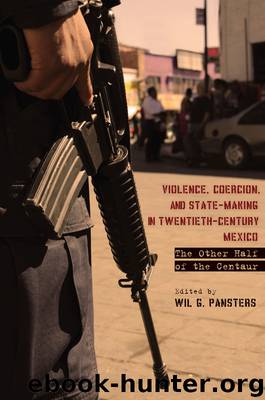Violence, Coercion, and State-Making in Twentieth-Century Mexico by Pansters Wil

Author:Pansters, Wil
Language: eng
Format: epub
Publisher: Stanford University Press
Published: 2012-03-20T16:00:00+00:00
CONCLUSION: LABOR VIOLENCE, 1920S TO 1950S
Mexico’s twentieth-century labor violence was also an expression of the changing nature of the postrevolutionary Mexican state, which explains the similarities and differences between the two episodes described in this chapter, the textile wars in the 1920s and the national railroad upheaval in the 1940s and 1950s. The background for this labor violence was the workers’ upheaval between 1910 and 1923 that smashed the old labor regime. Aspiring elites who came to power after 1917 were forced to accept a worker-created labor regime. Furthermore, they needed allies in the working class, just as their desire to modernize the economy meant they had to placate industrialists. How could the new state negotiate between these apparent enemies? It was a task that most twentieth-century Latin American governments failed to achieve, at the cost of military coups.99 Through the 1930s and 1940s this contradiction only deepened as the state sought to construct a new hegemony while building an industrial economy.
The solution was diabolical but effective. Mexico’s postrevolutionary labor regime placated workers by keeping the formal victories of the previous workers’ revolution (protections for unions and strikes) and strengthened working conditions for those in the formal sector of the economy, which grew significantly and thus provided new job opportunities in expanding industrial cities, especially Mexico City. The state, on the other hand, would placate owners by taking control of the labor movement away from a radicalized rank and file, substituting a compliant set of labor leaders beholden to the state for their power and prestige. Thus, through its control of key labor leaders, the state could provide labor peace. Through tariff adjustment, the state would also subsidize the increased labor costs that came about because of better working conditions. The only losers were democratically inclined workers and consumers, neither overly important in the construction of postrevolutionary hegemony.
The first attempt at carrying out this strategy was in the industry whose workers had been the core of the workers’ revolution, cotton textiles. During the 1920s, the chaotic politics of Mexico, with one governor succeeding another in rapid order, numerous political assassinations, and threatening national rebellions, meant that political elites could not directly attack labor. Therefore their strategy was to use allies within the labor movement to impose government control. The government’s strategy in Atlixco was typical of what it did throughout the country. Through its support of CROM violence, the federal government made Luis N. Morones and his organization the dominant labor power in Mexico, one that defended some gains of the workers’ revolution while subordinating workers to the state. Cromistas became municipal presidents, governors, senators, and federal deputies. Furthermore, state violence often appeared only indirectly as the state-supported armed labor groups rather than directly employ the army (which in the 1920s was largely influenced by local caudillos). The labor violence of that period was rough, but not rougher than the violence observed in the countryside or in national politics. And the labor violence appeared as a conflict among workers in which the state was neutral.
Download
This site does not store any files on its server. We only index and link to content provided by other sites. Please contact the content providers to delete copyright contents if any and email us, we'll remove relevant links or contents immediately.
| Arms Control | Diplomacy |
| Security | Trades & Tariffs |
| Treaties | African |
| Asian | Australian & Oceanian |
| Canadian | Caribbean & Latin American |
| European | Middle Eastern |
| Russian & Former Soviet Union |
The Secret History by Donna Tartt(18807)
The Social Justice Warrior Handbook by Lisa De Pasquale(12126)
Thirteen Reasons Why by Jay Asher(8767)
This Is How You Lose Her by Junot Diaz(6761)
Weapons of Math Destruction by Cathy O'Neil(6116)
Zero to One by Peter Thiel(5661)
Beartown by Fredrik Backman(5575)
The Myth of the Strong Leader by Archie Brown(5403)
The Fire Next Time by James Baldwin(5224)
How Democracies Die by Steven Levitsky & Daniel Ziblatt(5111)
Promise Me, Dad by Joe Biden(5077)
Stone's Rules by Roger Stone(5013)
100 Deadly Skills by Clint Emerson(4824)
A Higher Loyalty: Truth, Lies, and Leadership by James Comey(4822)
Rise and Kill First by Ronen Bergman(4682)
Secrecy World by Jake Bernstein(4618)
The David Icke Guide to the Global Conspiracy (and how to end it) by David Icke(4606)
The Farm by Tom Rob Smith(4421)
The Doomsday Machine by Daniel Ellsberg(4397)
